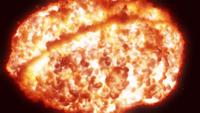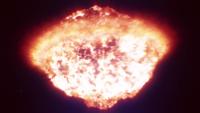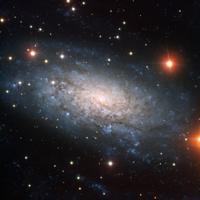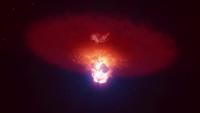This artist’s impression shows, about 22 million light-years away, the supernova SN 2024ggi exploding in the galaxy NGC 3621. (ESO/L. Calçada via SWNS)
By Dean Murray
Scientists have revealed for the first time a jaw-dropping early view of an exploding supernova.
Observations with the European Southern Observatory’s Very Large Telescope (ESO’s VLT) have revealed the explosive death of a star just as the blast was breaking through the star’s surface.
It offers new insights into the true shape of supernovae and shows that they display olive-shaped characteristics rather than spherical.
ESO said: “For the first time, astronomers unveiled the shape of the explosion at its earliest, fleeting stage. This brief initial phase wouldn’t have been observable a day later and helps address a whole set of questions about how massive stars go supernova.”
This artist’s impression shows, about 22 million light-years away, the supernova SN 2024ggi exploding in the galaxy NGC 3621. (ESO/L. Calçada via SWNS)
When the supernova explosion SN 2024ggi was first detected on the night of 10 April 2024 local time, Yi Yang, an assistant professor at Tsinghua University in Beijing, China, and the lead author of the new study, had just landed in San Francisco after a long-haul flight.
He knew he had to act quickly, so twelve hours later, he had sent an observing proposal to ESO, which, after a very quick approval process, pointed its VLT telescope in Chile at the supernova on 11 April, just 26 hours after the initial detection.
SN 2024ggi is located in the galaxy NGC 3621 in the direction of the constellation Hydra, ‘only’ 22 million light-years away – close by in astronomical terms. With a large telescope and the right instrument, the international team knew they had a rare opportunity to unravel the shape of the explosion shortly after it happened.
This image, from ESO’s Very Large Telescope (VLT), shows a truly remarkable galaxy known as NGC 3621. (ESO via SWNS)
The supernova’s progenitor was a red supergiant star, with a mass 12 to 15 times that of the Sun and a radius 500 times larger, making SN 2024ggi a classical example of a massive-star explosion.
Dietrich Baade, ESO astronomer and co-author of the study published in Science Advances, said: “The first VLT observations captured the phase during which matter accelerated by the explosion near the centre of the star shot through the star’s surface. For a few hours, the geometry of the star and its explosion could be, and were, observed together.”
“The geometry of a supernova explosion provides fundamental information on stellar evolution and the physical processes leading to these cosmic fireworks,” Yang explains.
This artist’s impression shows, about 22 million light-years away, the supernova SN 2024ggi exploding in the galaxy NGC 3621. (ESO/L. Calçada via SWNS)
ESO says the exact mechanisms behind supernova explosions of massive stars – those with more than eight times the mass of the Sun – are still debated and are among the fundamental questions scientists want to address.
ESO said: “With this knowledge, astronomers can already rule out some of the current supernova models and add new information to improve other ones, providing insights into the powerful deaths of massive stars.”
This image shows the location of the supernova SN 2024ggi in the NGC 3621 galaxy. It was taken on 11 April 2024, just 26 hours after the initial detection of the supernova. (ESO/Y. Yang et al. via SWNS)
Ferdinando Patat, ESO astronomer and study co-author, said: “This discovery not only reshapes our understanding of stellar explosions, but also demonstrates what can be achieved when science transcends borders.
“It’s a powerful reminder that curiosity, collaboration, and swift action can unlock profound insights into the physics shaping our Universe.”







